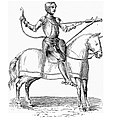Petronel
| External image | |
|---|---|

A petronel is a 16th and 17th century
Latin pectus) or it was carried slung from a belt across the chest. Petronels are found with either matchlock or wheellock mechanisms.[1]
The sclopus was the prototype of the petronel. The petronel is a compromise between the
cuirassiers. The petronel was succeeded by a similarly armed cavalryman called the harquebusier.[citation needed
]
Later developments
Although petronels had fallen out of use in Europe by 1700, similar guns were made in the Middle East until the late 19th century.
buttstock designed to keep the weapon close to the rider's chest.[citation needed
]
Gallery
-
Petronel of the end of the 15th century.
-
Early petronel, from a manuscript in the ancient library of Burgundy, by Glockenthon, of the arms of the Emperor Maximilian I (1505).
-
Cavalier Firing Petronel (After Marianus Jacobus).
-
Short barreled Afghan jezail from the early to mid 1800s.
See also
- Moukahla, North African musket
- Jezail, Afghan musket
- Musketoon, weapon with shorter barrel than a musket
- Carbine
Notes
- ^ Chisholm 1911, p. 333.
- ^ Clephan 1906, pp. 38–39.
- ^ Demmin (1894). pp. 68.
- ^ Demmin (1894). pp. 486.
References
- Clephan, Robert Coltman (1906). An outline of the history and development of hand firearms, from the earliest period to about the end of the fifteenth century. London: The Walter Scott Publishing Co. pp. 38–39.
- Demmin, Auguste (1894). An illustrated history of arms and armour: from the earliest period to the present time. New York: George Bell.
- Attribution
This article incorporates text from a publication now in the public domain: Chisholm, Hugh, ed. (1911). "Petronel". Encyclopædia Britannica. Vol. 21 (11th ed.). Cambridge University Press. p. 333.



